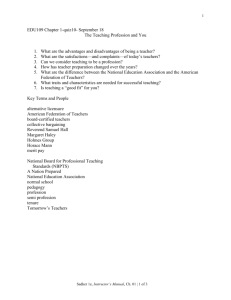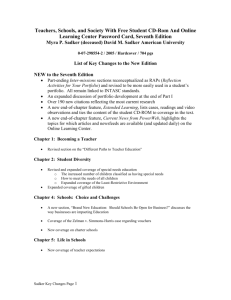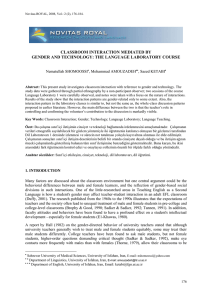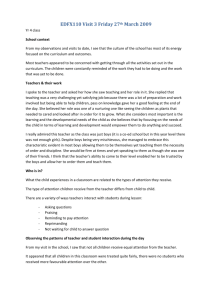Student Diversity Research Report 3
advertisement
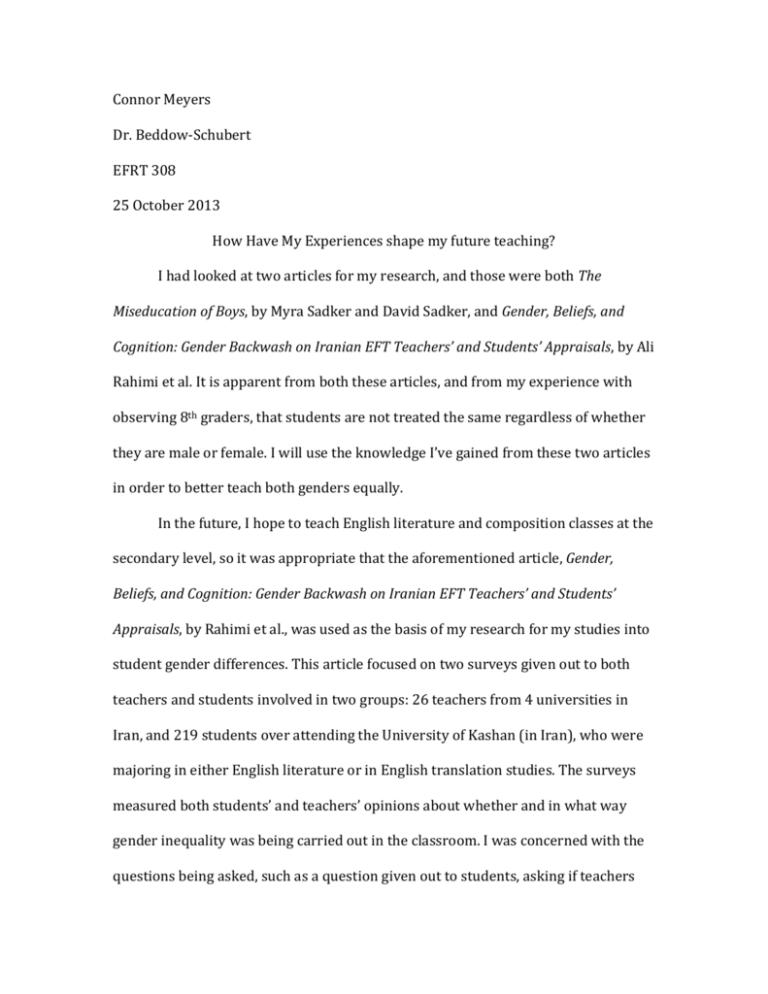
Connor Meyers Dr. Beddow-Schubert EFRT 308 25 October 2013 How Have My Experiences shape my future teaching? I had looked at two articles for my research, and those were both The Miseducation of Boys, by Myra Sadker and David Sadker, and Gender, Beliefs, and Cognition: Gender Backwash on Iranian EFT Teachers’ and Students’ Appraisals, by Ali Rahimi et al. It is apparent from both these articles, and from my experience with observing 8th graders, that students are not treated the same regardless of whether they are male or female. I will use the knowledge I’ve gained from these two articles in order to better teach both genders equally. In the future, I hope to teach English literature and composition classes at the secondary level, so it was appropriate that the aforementioned article, Gender, Beliefs, and Cognition: Gender Backwash on Iranian EFT Teachers’ and Students’ Appraisals, by Rahimi et al., was used as the basis of my research for my studies into student gender differences. This article focused on two surveys given out to both teachers and students involved in two groups: 26 teachers from 4 universities in Iran, and 219 students over attending the University of Kashan (in Iran), who were majoring in either English literature or in English translation studies. The surveys measured both students’ and teachers’ opinions about whether and in what way gender inequality was being carried out in the classroom. I was concerned with the questions being asked, such as a question given out to students, asking if teachers showed gender preference at towards students. As it turns out, 38.5 percent of students thought that teachers show preference towards gender, 62.1 percent of students state that teachers show a preference to the opposite gender, and 44 percent (almost half) of students think they have been discriminated against due to gender. Although any data that asks student’s thoughts on their teachers may yield to be inaccurate, it is important to note that if such a large percentage may be taking offense by their teachers, there is clearly a need for teachers to consider that they may not be treating students fairly. Taking a look at this article makes it clear that discrimination may be taking place without the teacher’s knowledge, and may, in fact, be built into the culture (as this study was not conducted in the United States). Contrasting with that idea is the fact that 69.3 percent of the teachers interviewed thought that students were being treated in a gender-inclusive manner, there is clearly a disconnect between how the teachers thought they were treating the students, and how students perceive the gender-biased methods taught by their teachers. Upon reading the Miseducation of Boys article, by Myra Sadker and David Sadker, which explains that male students are given the majority of the teacher’s attention in school, due to their acting out with aggressive behavior, even though girls are typically the students who have better grades. Say Sadker and Sadker, “[t]eachers say males are brighter, better at Science and math, and more likely to become the nation's future leaders. “ However, one of the other important quotes of the article continues, “When teachers remember their worst students-the discipline problems, the ones most likely to create a classroom disturbance or to flunk out of school-they still list boys.” This is more in tune with the experience I’ve had with my observation of teaching methods in the middle school, and it implies that males are given an unfair advantage in the classroom regardless of their performance. History has traditionally allowed for men to dominate the academic life, regardless of performance, and I hope to change that when I become a teacher. Females have various hurdles to overcome, and may not try to compete for the teachers’ attention. I believe that it will be my responsibility, and the responsibility of all teachers, to assume that all students should be given equal attention by the teacher, and more often positive than negative in order to encourage students to work their hardest. In the past, I have done my field experience at the eighth grade level, in middle school. This age is perfect for observing gender inequality because most students at that point would be defined as adolescents, and have started experiencing the differences between being male and female. I have definitely noticed the treatment of students as those in the Miseducation of Boys article, specifically dealing with the fact that boys would usually be treated as less attentive. Sadker and Sadker mention in their article that boys, “[r]aised to be active, aggressive, and independent, […] enter schools that seem to want them to be quiet, passive, and conforming.” Strangely enough, this contrasts with my experiences at the middle-school level. Many of the males in the classroom would typically keep to themselves unless called on, almost as if trying to act as if they weren’t trying to work too hard; on the other hand, females were the ones chosen by the teacher to answer questions, and the female students were more willing to contribute to the class discussions. It’s interesting to note that many of the males in this group were also those scolded the most by the teachers. If male students are not given positive attention, and are scolded by the teacher more frequently, as in my field experience, it’s possible that this may lead to an even worse situation than one where male students are given attention for acting more aggressively. This may act as something of a self-fulfilling prophecy, then: if male students act like they aren’t trying to do work, and are often given discouraging remarks that they are not doing well in school, the students may start to assume that they aren’t smart enough to continue with school, and may end up falling to the bottom of the class. Girls, on the other hand, were given encouraging remarks in my field experience, such as, “thank you for coming prepared to class.” I can’t be certain how this English teacher was able to keep the students under control, but I know that if I’m able to teach in the classroom someday, I have to make sure that I don’t allow either male or female students to be given more attention than the opposite gender. Although it is not always possible to give students an equal amount of attention, it seems to be the case that teachers would benefit from the understanding that students are often treated unfairly based on their gender, and that it is the responsibility of the teacher to ensure that students are positively reinforced to do their best in school. I have come to this realization based on these two articles and my experience in the field, and it is through these that I hope this conversation continues. Works Cited Rahimi, A., Fallahi, A., & Samigorganroodi, G. (2013). Gender, Beliefs, and Cognition: Gender Backwash on Iranian EFL Teachers' and Students' Appraisals. International Journal Of Social Sciences & Education, 3(3), 706-716.
